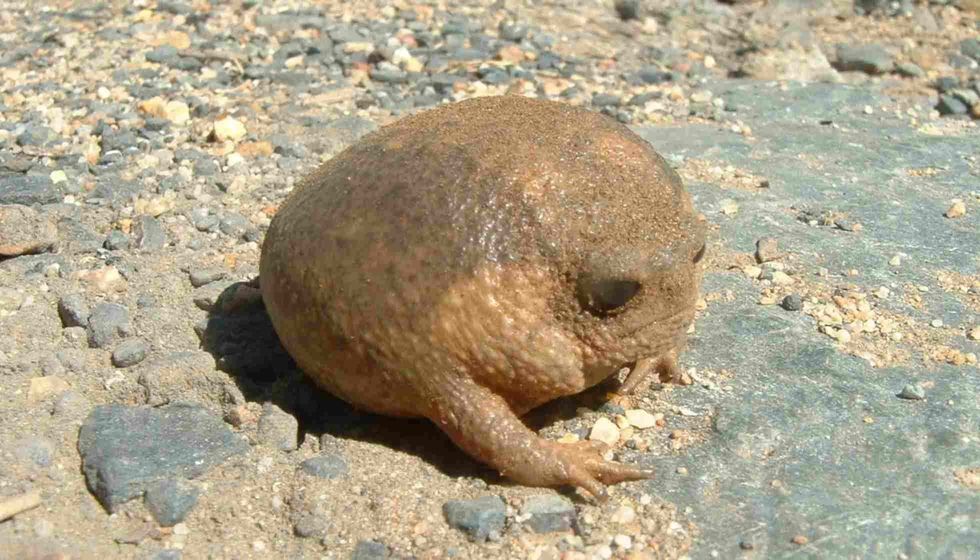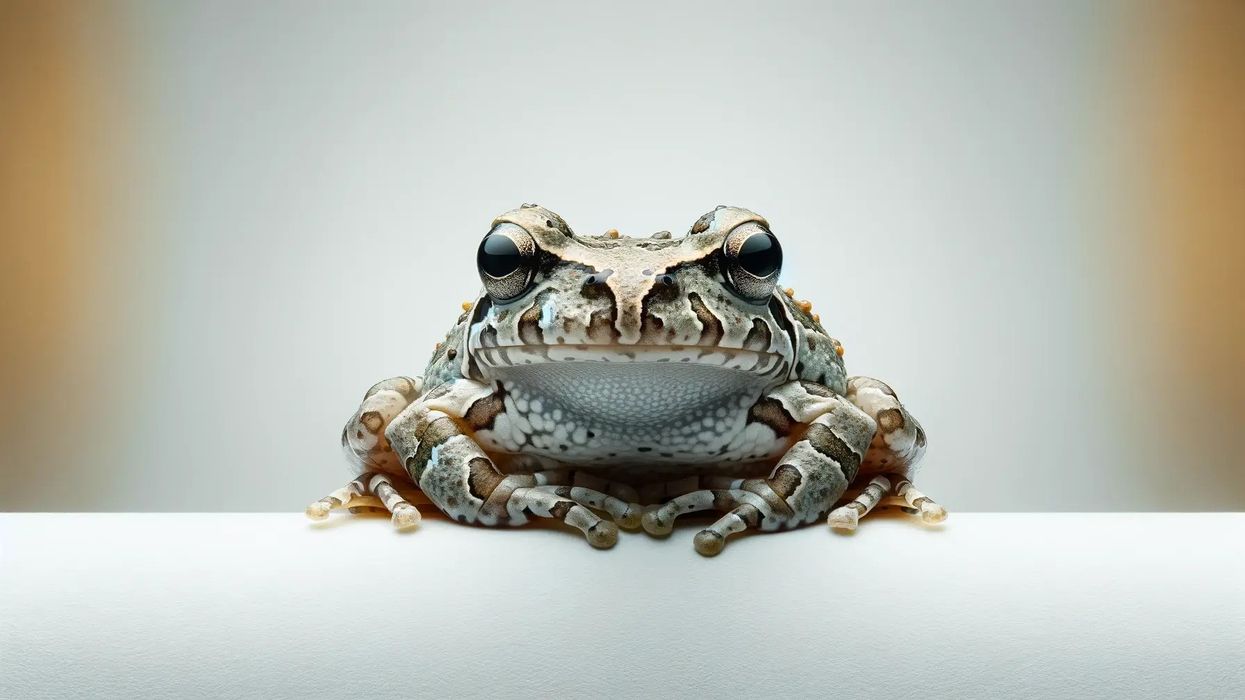The Cape rain frog (Breviceps gibbosus) is a breed of burrowing frog that is endemic to South Africa. The distribution of this frog is usually towards the south-western Cape of South Africa, southwards to the central Cape peninsula, and northwest area towards Citrusdal.
They belong to the Brevicipitidae of the Breviceps genus. Their habitat usually includes rural gardens, agricultural farms, and areas with shrubby vegetation. You can easily identify the Cape rain frog because of their coarse brown skin and cream-dotted pattern on their belly.
The muscular legs of this species are usually shorter than the body and the skin is usually very coarse. They feed on small insects like worms or termites.
As the name suggests, the South African Cape rain frog emerges only when it rains and usually lives underground. The burrowing males call out for females during the breeding season.
The females locate them and lay 22 eggs after fertilization. These South African frogs do not need any open water to breed as the froglets mature without going through a tadpole stage. The conservation status of this breed is Near Threatened and is rapidly decreasing due to habitat loss.
Scroll down to read more interesting facts about the Cape rain frog. If you like this species, then you can also check out the Pacman frog and Amazon milk frog.
Cape Rain Frog Interesting Facts
What type of animal is a Cape rain frog?
The Cape rain frog, Breviceps gibbosus, is a species of frog native to South Africa.
What class of animal does a Cape rain frog belong to?
The Cape rain frog belongs to the class of amphibians from the Breviceps genus of the family. The scientific name is Breviceps gibbosus.
How many Cape rain frogs are there in the world?
There are no studies about the exact population size of the Cape rain frog. As a Near Threatened species, their numbers must be steadily decreasing.
Where does a Cape rain frog live?
The Cape rain frog, Breviceps gibbosus, is endemic to South Africa and is not found outside of its range. It is usually spotted in the far south-western Cape of South Africa, southwards to the central Cape peninsula and northwest towards Citrusdal.
What is a Cape rain frog's habitat?
The habitat of Cape rain frog species is very varied and generally includes shrubby vegetation. They inhabit farms, agricultural land, rural gardens, residential gardens, and urban areas as well. This frog lives underground until it rains.
Who do Cape rain frogs live with?
The Cape rain frog is a solitary animal species that prefers staying alone and is rarely seen in packs. This species can be found in pairs during breeding season only. They will live as a family and females protect the froglets until they are fully grown.
How long does a Cape rain frog live?
The lifespan of a South African Cape rain frog is unknown. They may live as much as their cousin species, the desert rain frog, which is usually 4-15 years.
How do they reproduce?
The breeding season of the Cape rain frog is usually aligned with the rainy season of South Africa. The male Cape rain frog hides under vegetation during the breeding season and calls out to the females.
Females locate them and secretes a sticky liquid that glues the male on her back. After fertilization, the female lays about 22 eggs in a burrow. Fertile eggs are laid in a jelly capsule providing moisture to the froglets.
They do not require water to breed and the froglets do not undergo the tadpole stage. The females protect eggs until babies are fully formed.
What is their conservation status?
The conservation status of the South African Cape rain frog is Near Threatened, which means their number is steadily decreasing.
Cape Rain Frog Fun Facts
What do Cape rain frogs look like?
The Cape rain frog, Breviceps gibbosus, has a round body with forward-facing eyes. They have a small snout and the muscular legs are shorter than the body.
The skin is very coarse and it is usually brown with a cream color dotted on the belly. The male Cape rain frog tends to have coarser skin on the throat as compared to the females. Their toes are thick and do not have any webbing.
They are also short just like the legs. Because of their appearance, it is easy to confuse them with a rock if seen in burrows from afar.
How cute are they?
The Cape rain frog is small and looks like a round ball. When feeling angry or threatened, they can puff up their body to look bigger. Their voice is also like high-pitched 'squee' and it almost sounds like you are pressing a rubber duck. It's absolutely adorable!
How do they communicate?
The Cape rain frog species mainly communicate using sound. During the breeding season, the males can call for the females from the burrows. This sound is like a harsh squawking with short intervals.
How big is a Cape rain frog?
The average size of a Cape rain frog, Breviceps gibbosus, is around 2 in (4.5 cm). They are only about three times the size of a honey bee.
How fast can a Cape rain frog jump?
There are no studies that estimated the speed or height at which the Cape rain frog species can jump.
How much does a Cape rain frog weigh?
The weight of a Cape rain frog species is unknown.
What are the male and female names of the species?
There are no specific names for the male and female Cape rain frog.
What would you call a baby Cape rain frog?
A baby Cape rain frog is known as a froglet.
What do they eat?
Cape rain frogs are mainly insectivorous. They feed on worms, termites, and other insects. There is no record about their predators, but just about any large animal species can prey on them.
Are they dangerous?
Cape rain frogs are not dangerous and do not usually interact with humans. When they do, they are usually terrified of humans.
Would they make a good pet?
Cape rain frogs are wild animals and would not make a good pet.
Did you know...
A video of the Cape rain frog, Breviceps gibbosus, went viral after it was caught screaming by Simon Van Nierop in Cape Town. The internet loved the video as the Cape rain frogs sound like an angry squeaky toy. However, experts believe that the viral video is actually sad because the animal looked very distressed and scared.
What is the specific range of the Cape rain frog?
The Cape rain frogs are endemic to South Africa.
Is Cape rain frog endangered?
The Cape rain frogs are Near Threatened and their population is likely to become endangered within the foreseeable future. Conservative methods will be needed for the Breviceps gibbosus to restore their numbers.
Here at Kidadl, we have carefully created lots of interesting family-friendly animal facts for everyone to discover! Learn more about some other amphibians from our leopard frog facts and red-eyed tree frog facts pages.
You can even occupy yourself at home by coloring in one of our free printable cape rain frog coloring pages.










